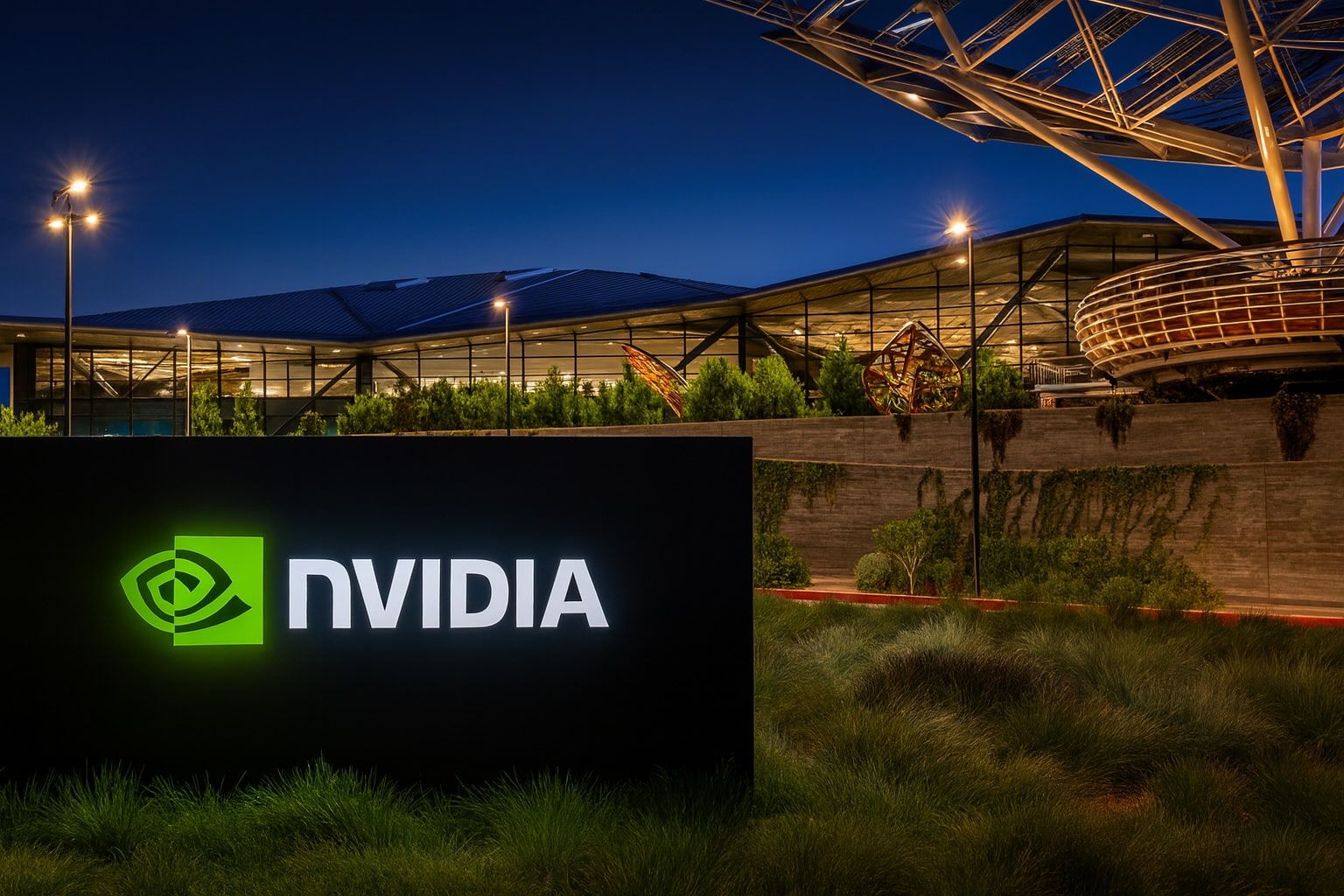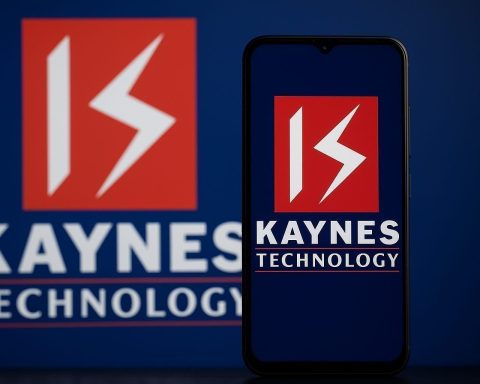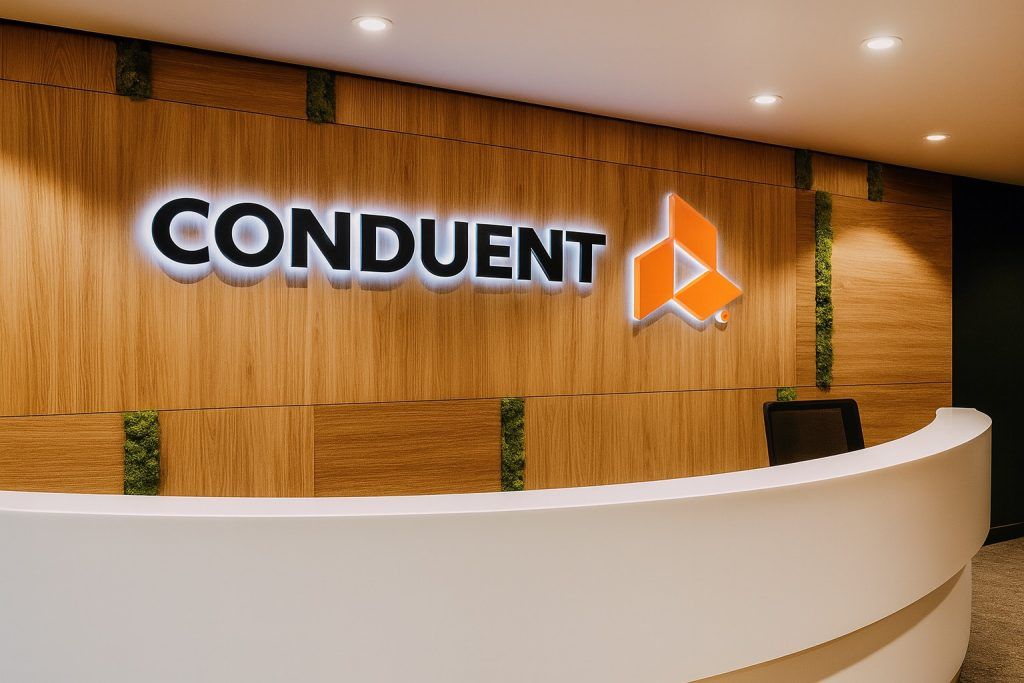- NVDA stock nears all-time highs: Nvidia’s share price hit around $207 this week, vaulting the chipmaker’s market capitalization above $5 trillion amid a frenzied AI-driven rally (up ~30% year-to-date, far outpacing the S&P 500) [1] [2].
- Historic valuation milestone: Nvidia became the world’s first $5 trillion public company [3] after announcing massive AI initiatives – including $500 billion in new chip orders and plans to build seven AI supercomputers for the U.S. government – that cement its central role in the booming AI industry [4].
- AI mega-deals galore: In recent weeks, Nvidia unveiled a $100 billion partnership to supply ~10 GW of GPUs to OpenAI, invested $5 billion in Intel to co-develop next-gen chips, and joined a $40 billion consortium (with BlackRock, Microsoft, etc.) to acquire data centers for cloud AI capacity [5]. CEO Jensen Huang is also forging new alliances globally – meeting with Samsung and Hyundai in South Korea to expand AI partnerships [6] [7] – as the company extends its reach across tech and automotive sectors.
- Rivals chase the AI crown: Competition in AI chips is heating up. AMD’s stock soared 34% after it inked a deal to supply OpenAI with roughly 6 GW of GPUs (even giving OpenAI an option for a 10% stake) [8], and Qualcomm jumped 11% by launching new AI chips to challenge Nvidia [9]. Yet analysts say Nvidia still “sells every AI chip it can make,” as demand remains insatiable even with new players entering the market [10].
- Wall Street bullish – with a caveat: Roughly 80–90% of analysts rate NVDA a “Buy,” with consensus 12-month price targets in the $210–$220 range [11]. Some top bulls see far more upside (one major firm raised its target to $320, implying ~70% gain) [12]. “Don’t sleep on Nvidia” in the AI era, one upbeat analyst urged [13]. However, at ~50× earnings the stock is “priced for perfection,” warns the lone bearish analyst, who calls the AI boom “not my first bubble” and pegs NVDA’s value closer to $100 [14].
- Blowout financials & high stakes: Nvidia’s latest earnings validated the hype – revenue surged 56% last quarter to $46.7 billion with gross margins over 72%, fueled by explosive demand for its AI data-center chips [15]. The company projects ~54% year-on-year growth next quarter (around $54 billion in revenue) [16], putting it on track to exceed $200 billion in annual sales for the first time. Another blockbuster report on November 19 is anticipated. Yet sustaining such torrid growth is vital to justify Nvidia’s rich valuation. The company must continue to meet sky-high expectations – and navigate risks like U.S. export curbs (which threaten ~10–15% of its sales in China) – to support its stratospheric stock price [17].
NVDA Stock at Record Highs Amid AI Frenzy
Nvidia’s stock has been on a tear in late 2025, repeatedly flirting with all-time highs. Shares closed at about $207 on Oct. 29, a new record that put Nvidia’s market capitalization around $5.03 trillion [18]. This milestone makes Nvidia the first company ever to reach a $5 trillion valuation, underscoring how dramatically it has ascended on the back of the AI boom [19]. Year to date, NVDA is up roughly 30%, vastly outperforming the S&P 500 index’s gains [20]. The stock has now leaped about 58% from one year ago and stands nearly 12× higher than its level in early 2022 before the AI frenzy began [21]. Investor enthusiasm remains intense – even minor dips have been met with eager “buy the dip” flows, reflecting Nvidia’s status as the market’s premier AI play [22].
The rally accelerated this week amid positive macro news and trade optimism. Hopes for easing U.S.–China tensions (ahead of a meeting between President Donald Trump and China’s President Xi Jinping) and cooling inflation bolstered risk appetite for tech stocks [23]. Nvidia, often seen as a bellwether of the AI trade, jumped nearly 3% on Oct. 27 to ~$190.7 [24] and then surged toward $197–$198 intraday on Oct. 28 [25]. By mid-week, on news of major Nvidia announcements, the stock broke out to fresh highs near $207. “Nvidia hitting a $5 trillion market cap is more than a milestone; it’s a statement,” said Matt Britzman, a senior analyst at Hargreaves Lansdown, noting Nvidia’s transformation from chip maker to “industry creator” and calling it one of the best ways to play the AI theme [26].
AI Mega-Deals Drive Unprecedented Growth
Behind Nvidia’s meteoric surge is a string of blockbuster deals and announcements that have solidified its dominance in the AI arena. In just the past few days, CEO Jensen Huang revealed that Nvidia has amassed $500 billion in AI chip orders from customers – an eye-popping figure that highlights insatiable demand for its GPUs [27]. Huang also announced Nvidia will build seven cutting-edge supercomputers for the U.S. government [28], partnering with firms like Oracle to supply up to 100,000 of its new “Blackwell” processors for national security and research uses [29]. These U.S. projects, part of the government’s investment in AI infrastructure, underscore Nvidia’s strategic importance at the highest levels of tech and defense.
At the same time, Nvidia is rapidly expanding via partnerships and investments to secure its future growth. The company recently inked a $100 billion deal with OpenAI to provide roughly 10 gigawatts of GPUs over the coming years [30] – a massive long-term supply agreement ensuring OpenAI (the firm behind ChatGPT) has access to Nvidia’s AI hardware. “Everything starts with compute,” OpenAI CEO Sam Altman said of the landmark partnership, underscoring that Nvidia’s chips will be at the heart of future AI breakthroughs [31]. Nvidia’s stock jumped over 4% on that news, reflecting investor euphoria over effectively “guaranteed” demand for its GPUs [32].
In addition, Nvidia took a $5 billion equity stake in Intel to co-develop next-generation semiconductor technology [33] – an unusual alliance between rivals that could boost Nvidia’s manufacturing capacity and diversify its chip supply. The company also joined forces with industry giants BlackRock, Microsoft, and others in a $40 billion consortium to acquire Aligned Data Centers [34], adding about 5 gigawatts of new capacity for AI cloud computing. And in a nod to expanding beyond its traditional business, Nvidia invested $1 billion in Nokia to collaborate on AI-powered networking and data center projects [35]. These moves all aim to lock in years of growth, ensuring Nvidia’s GPUs remain the backbone of an ever-expanding AI ecosystem.
Even globally, Nvidia’s deal-making hasn’t slowed. This week in South Korea, Jensen Huang met with the chiefs of Samsung Electronics and Hyundai Motor during his first official visit in a decade [36]. Over Korean fried chicken and beer, Huang discussed deepening partnerships in both tech and autos – even teasing upcoming deals with Korean firms that would “please U.S. President Donald Trump and South Korea,” according to Huang [37]. Samsung is a key player in memory chips and chip manufacturing, while Hyundai is exploring AI for autonomous driving; closer ties with both signal Nvidia’s intent to embed its AI technology across industries. Hundreds of fans and media swarmed the Seoul restaurant to glimpse Huang – a rockstar reception befitting the CEO of a $5 trillion tech titan [38].
Expert Commentary on Nvidia’s Outlook
Wall Street analysts remain overwhelmingly bullish on Nvidia, though a few urge caution given the stock’s rapid ascent. Around 80–90% of analysts rate NVDA as a “Buy,” with the average 12-month price target clustered around $210–$220 per share [39] (roughly 15% above current levels). Many argue that Nvidia’s unrivaled position at the center of the AI boom justifies these lofty expectations. “Nvidia has gone from chip maker to industry creator,” said Britzman of Hargreaves Lansdown, emphasizing that the market still underestimates the scale of the AI opportunity Nvidia can capture [40]. Likewise, other bulls highlight Nvidia’s explosive growth and dominant market share: “Don’t sleep on Nvidia” in the AI era, one upbeat analyst urged, implying the company will continue to surprise to the upside as AI adoption spreads [41]. Some of the most optimistic forecasts now even imagine Nvidia one day approaching a $10 trillion valuation if AI truly transforms the economy, a notion that would have seemed far-fetched only a year ago [42].
However, not everyone is fully on board with the hype. With the stock at $200+ and trading around ~50 times earnings, at least one prominent analyst is sounding alarm bells. “This isn’t my first bubble,” cautions Jay Goldberg of Seaport Global, the lone analyst with a outright Sell rating on Nvidia [43]. He argues that Nvidia is “priced for perfection” and sees “a lot more that can go wrong… than can go right” from here [44]. Goldberg – whose ultra-bearish price target of $100 implies a ~50% collapse – likens the AI investment frenzy to the dot-com era, warning that today’s frenetic spending on AI could eventually “tumble down” if the technology’s payoff doesn’t live up to sky-high expectations [45]. While his view is very much in the minority, it underscores the risks of over-exuberance. Even some investors bullish on Nvidia acknowledge the stock’s rich valuation leaves “little room for error” going forward [46].
Market strategists also note that Nvidia’s size and influence mean its stock swings can reverberate through the broader market. As part of the “Magnificent Seven” mega-cap tech cohort, Nvidia’s movements heavily sway the S&P 500 and Nasdaq indices [47]. This outsized impact is a double-edged sword: confidence in Nvidia’s AI narrative has lifted sentiment market-wide, but any stumble could likewise weigh on tech stocks broadly. “AI’s current expansion relies on a few dominant players financing each other’s capacity,” observes Matthew Tuttle, CEO of Tuttle Capital. If investors one day shift focus from growth to profits, “some of these flywheels could seize,” Tuttle warns, hinting at the potential for an abrupt reversal if the AI hype cools [48]. For now though, momentum around Nvidia appears strong, and most experts maintain an upbeat outlook – albeit with eyes wide open regarding the execution needed to sustain it.
Financial Performance Validates the Hype
Nvidia’s fundamentals have been staggering, backing up the market’s enthusiasm. In its most recent quarter (Fiscal Q2 2026, covering May–July 2025), Nvidia’s revenue soared 56% year-on-year to $46.7 billion – an almost unheard-of growth rate for a company of its size [49]. This “blowout” quarter saw net income rocket 59% to $26.4 billion, with GAAP gross margins of 72.4% [50]. To put those figures in perspective, roughly 88% of Nvidia’s sales ($41 billion) now come from its data-center division – primarily the high-end A100, H100, and new Blackwell series GPUs that power advanced AI models [51]. These chips, essentially the “engines” of modern AI, are yielding extraordinary profitability. Such results dramatically exceeded Wall Street’s forecasts, and Nvidia’s executives have signaled that demand still far outstrips supply. As CEO Jensen Huang put it, “demand is extraordinary” for Blackwell, which he calls “the AI platform the world has been waiting for” [52].
Off the back of these results, Nvidia issued an optimistic forecast for the upcoming quarter (Q3 FY2026). The company guides for about $54 billion in revenue for the quarter ending Oct. 2025 – roughly 54% growth from the same period a year prior [53]. If achieved, Nvidia would be on pace to cross $200 billion in annual revenue for the first time [54], an astonishing figure that was unfathomable just a couple years ago. Little wonder investors have been willing to bid the stock to new heights. Nvidia’s coffers are also overflowing – it generated tens of billions in free cash flow and has returned over $24 billion to shareholders via buybacks and dividends in the first half of the year [55] [56]. In late August, Nvidia’s board authorized an additional $60 billion for share repurchases [57], reflecting confidence in the company’s future and providing further support to the stock.
All eyes are now on November 19, 2025, when Nvidia will report its next quarterly earnings. Analysts widely expect another beat-and-raise performance, given Nvidia’s own bullish guidance and the evident tailwinds from AI spending [58]. Anything close to the projected $54 billion in Q3 sales would confirm that the AI boom is sustaining momentum into year-end. Such an outcome could very well fuel NVDA’s next leg higher – with some predicting the stock could make a run toward that $300 level if growth shows no sign of slowing [59]. Conversely, any hint of demand cooling or supply bottlenecks could spook investors. With the stock priced for perfection, even a slight miss or cautious outlook might trigger a sharp pullback as traders rapidly recalibrate expectations [60]. In short, Nvidia’s financial performance will need to keep delivering jaw-dropping numbers to support its valuation – a high bar that the company so far has cleared with ease, but one that will be closely scrutinized going forward.
AI Industry Trends and Competitive Landscape
Nvidia’s meteoric rise comes as the AI revolution is transforming the tech sector, creating enormous opportunities – and drawing fresh competition. Thus far, Nvidia has enjoyed a virtual monopoly in cutting-edge AI accelerators, with its GPUs powering an estimated 80–90% of new AI workloads globally. The company’s dominance, however, is attracting rivals intent on claiming a slice of the burgeoning market.
Notably, AMD (Advanced Micro Devices) has emerged as a viable challenger in AI chips. In late October, AMD announced a major deal to supply 6 gigawatts of GPU capacity to OpenAI starting in 2026, even offering OpenAI the option to take a 10% ownership stake in AMD as part of the partnership [61]. The news sent AMD’s own stock surging 34% in a single day [62], as investors bet that AMD could ride the AI wave alongside Nvidia. AMD is set to roll out its MI300 series accelerators, and cloud giants like Oracle have reportedly agreed to deploy tens of thousands of these AMD chips in their data centers [63]. Similarly, Qualcomm – known for mobile chips – unveiled new AI chips targeting data centers, causing its stock to jump over 10% [64] on optimism that it could capture niche AI workloads. Even startups and AI-focused semiconductor newcomers (from Google’s TPUs to custom silicon by Meta, Amazon, and others) are vying for a piece of what is expected to be a trillion-dollar AI hardware market in coming years.
So far, these competitive moves have not materially dented Nvidia’s trajectory. “For now Nvidia sells every AI chip it can produce,” one analyst noted, emphasizing that demand is so far ahead of supply that multiple winners can thrive [65]. In the near term, the AI compute pie is expanding fast enough that Nvidia’s growth isn’t zero-sum – rivals’ gains have come more at the expense of unmet demand rather than by displacing Nvidia’s chips [66]. Moreover, Nvidia holds key advantages: its CUDA software ecosystem and developer community remain unmatched, making it hard for customers to switch to alternatives despite any pricing or supply incentives. Still, Nvidia isn’t standing still. To ensure it stays ahead, the company is partnering with firms like TSMC, Samsung, and even Intel to expand chip manufacturing capacity [67]. It’s also supporting the build-out of so-called “AI factories” – massive cloud data centers dedicated to AI R&D – often with Nvidia investing capital to guarantee those facilities use its GPUs [68]. These efforts should help alleviate any supply constraints over time, allowing Nvidia to keep up with ravenous demand.
Beyond chips, Nvidia’s growth is buoying a whole AI supply chain. Suppliers like memory-maker SK Hynix have been selling out their inventory – Hynix said it has already pre-sold its entire high-end memory chip output for 2026, thanks to orders feeding Nvidia GPU systems [69]. Cloud providers and enterprise software firms are racing to optimize for Nvidia’s hardware, while a wave of AI startups (in areas from autonomous vehicles to healthcare) are emerging as new customers. In effect, Nvidia has become the central platform of the AI era, and its fortunes are tightly intertwined with the overall progress of AI technology.
Geopolitical and Regulatory Factors
Despite its strong hand, Nvidia faces geopolitical challenges that could impact its growth, particularly regarding China. The U.S. government has imposed strict export controls on advanced semiconductors, which directly affect some of Nvidia’s most lucrative products (like the A100, H100, and forthcoming Blackwell GPUs). These curbs, aimed at limiting China’s access to cutting-edge AI technology, have already had an impact: Nvidia has estimated that roughly 10–15% of its annual revenue could be at risk from loss of Chinese sales [70]. To mitigate this, Nvidia began offering modified, lower-performance versions of its chips (e.g., the A800) that comply with U.S. rules. However, China has pushed back – reportedly halting certain orders and increasing inspections of Nvidia’s chips in retaliation [71]. Rumors of even tighter U.S. restrictions on AI chip exports have periodically rattled Nvidia’s stock in recent months [72], reflecting investor jitters over a potential hit to one of Nvidia’s largest markets.
The U.S.–China tech standoff took center stage this week as President Trump met with China’s President Xi in South Korea. Ahead of the summit, Trump had suggested he’d broach the topic of Nvidia’s Blackwell AI chips, which have been a major sticking point in trade talks [73]. He even lauded Blackwell as a “super duper” chip and hinted that opening sales to China could be on the table – potentially unlocking billions in additional revenue for Nvidia if realized [74]. However, after the meeting, Trump clarified that he did not explicitly discuss the Blackwell chip with Xi [75], though broader talks about Nvidia’s access to the Chinese market did occur. Nvidia’s CEO Jensen Huang, who was present in South Korea, diplomatically said he’s “confident” the two leaders “had a very good conversation” regarding tech trade [76]. Any easing of export restrictions would be a boon for Nvidia, but for now the regulatory status quo remains, and the company will have to continue navigating an uncertain U.S.–China dynamic.
Meanwhile, Nvidia’s sheer size and influence have drawn attention from regulators beyond just export controls. In the U.S. and Europe, officials are increasingly scrutinizing the AI industry’s dependency on a single supplier (Nvidia) and weighing policies to boost domestic chip alternatives. Thus far, there have been no serious antitrust actions against Nvidia, but the company’s dominance in a critical technology has put it under a policy microscope. Paradoxically, Nvidia has actively courted government support – Huang has been vocal about aligning Nvidia’s goals with national interests. He praised Trump’s “America First” tech investment policies this week for spurring domestic chip production [77], even as he cautioned that completely cutting off China could backfire by excluding U.S. firms from half the world’s AI talent [78]. This highlights Nvidia’s delicate balancing act: it is trying to keep favorable relations with Washington while not losing access to key global markets.
Another geopolitical risk looms in the background: Taiwan. Nvidia relies on Taiwan’s TSMC to fabricate its most advanced chips. Any escalation of cross-strait tensions or conflict involving Taiwan could severely disrupt Nvidia’s supply chain and the broader tech industry [79]. This is one reason Nvidia is investing in new chip fabs (like the plan to manufacture Blackwell GPUs in Arizona) – to diversify production and reduce over-reliance on one region [80]. For now, such worst-case scenarios remain hypothetical, but they are a reminder that Nvidia’s fortunes, however bright, are not without external risks.
The Road Ahead: High Expectations and Big Rewards
As of late October 2025, Nvidia stands at the pinnacle of the tech world – its valuation and growth prospects bolstered by an AI revolution that shows little sign of abating. The company’s recent triumphs, from jaw-dropping financial results to headline-grabbing deals, have positioned it as the indispensable supplier of “pickaxes” in the modern AI gold rush. Looking forward, the key question for investors is whether Nvidia can keep up its torrid pace and continuously clear the high bar it has set. Bulls argue that we are in the early innings of a decades-long AI transformation, with Nvidia’s hardware underpinning breakthroughs in everything from generative AI and cloud computing to self-driving cars and healthcare. In this optimistic scenario, Nvidia could have years of secular growth ahead, potentially justifying even more upside in the stock. It’s telling that some analysts have mused about a future $7 trillion or $10 trillion market cap for Nvidia if AI truly infiltrates every industry [81] [82].
On the other hand, skeptics note that trees don’t grow to the sky. Nvidia’s market cap now exceeds the GDP of many G7 countries; maintaining its growth trajectory will eventually become challenging simply due to its massive scale. Any sign of the AI spending boom leveling off – or a competitor making a serious dent in Nvidia’s edge – could quickly deflate the exuberance. The stock’s high valuation means execution must be nearly flawless to support it. As one market watcher put it, Nvidia has become the ultimate high-reward, high-risk bet on AI’s future [83]. For now, investors appear happy to strap in for the ride: momentum is clearly in Nvidia’s favor, and each quarter of blowout earnings or new multi-billion-dollar deal only adds fuel to the rally. Whether NVDA stock’s stratospheric heights are justified or headed for a reality check will likely be determined in the coming months by Nvidia’s ability to deliver on the world’s lofty expectations – and by the broader course of the AI revolution that the company is so profoundly powering [84].
Sources: ts2.tech; Reuters; Nvidia investor reports; Yahoo Finance; 24/7 Wall St.; Investopedia; Bloomberg. [85] [86] [87] [88] [89] [90] [91] [92]
References
1. www.reuters.com, 2. ts2.tech, 3. www.reuters.com, 4. www.reuters.com, 5. ts2.tech, 6. www.reuters.com, 7. www.reuters.com, 8. ts2.tech, 9. ts2.tech, 10. ts2.tech, 11. ts2.tech, 12. ts2.tech, 13. ts2.tech, 14. ts2.tech, 15. ts2.tech, 16. ts2.tech, 17. ts2.tech, 18. www.reuters.com, 19. www.reuters.com, 20. ts2.tech, 21. www.reuters.com, 22. ts2.tech, 23. ts2.tech, 24. ts2.tech, 25. ts2.tech, 26. www.reuters.com, 27. www.reuters.com, 28. www.reuters.com, 29. 247wallst.com, 30. ts2.tech, 31. ts2.tech, 32. ts2.tech, 33. ts2.tech, 34. ts2.tech, 35. 247wallst.com, 36. www.reuters.com, 37. www.reuters.com, 38. www.reuters.com, 39. ts2.tech, 40. www.reuters.com, 41. ts2.tech, 42. ts2.tech, 43. ts2.tech, 44. ts2.tech, 45. ts2.tech, 46. ts2.tech, 47. www.reuters.com, 48. www.reuters.com, 49. ts2.tech, 50. ts2.tech, 51. ts2.tech, 52. ts2.tech, 53. ts2.tech, 54. ts2.tech, 55. nvidianews.nvidia.com, 56. nvidianews.nvidia.com, 57. nvidianews.nvidia.com, 58. ts2.tech, 59. ts2.tech, 60. ts2.tech, 61. ts2.tech, 62. ts2.tech, 63. ts2.tech, 64. ts2.tech, 65. ts2.tech, 66. ts2.tech, 67. ts2.tech, 68. ts2.tech, 69. 247wallst.com, 70. ts2.tech, 71. ts2.tech, 72. ts2.tech, 73. 247wallst.com, 74. 247wallst.com, 75. www.reuters.com, 76. www.reuters.com, 77. www.reuters.com, 78. www.reuters.com, 79. ts2.tech, 80. 247wallst.com, 81. www.reuters.com, 82. ts2.tech, 83. ts2.tech, 84. ts2.tech, 85. www.reuters.com, 86. www.reuters.com, 87. ts2.tech, 88. 247wallst.com, 89. ts2.tech, 90. ts2.tech, 91. ts2.tech, 92. ts2.tech







